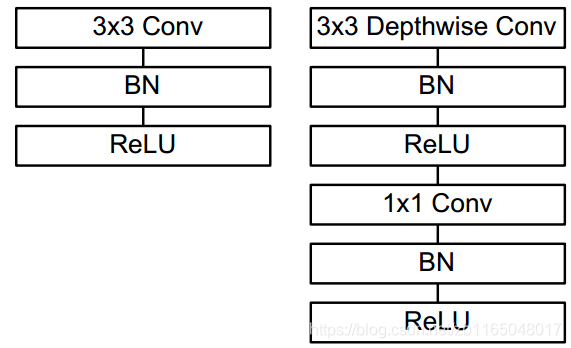前言
轻量级神经网络中,比较重要的有MobileNet和ShuffleNet,其实还有其它的,比如SqueezeNet、Xception等。
本博客为MobileNet的前两个版本的理论简介与Keras中封装好的模块的对应实现方案。
国际惯例,参考博客:
纵览轻量化卷积神经网络:SqueezeNet、MobileNet、ShuffleNet、Xception
为什么MobileNet及其变体如此之快?
【Tensorflow】tf.nn.depthwise_conv2d如何实现深度卷积?
Keras-application中的实现
MobileNetV1论文
MobileNetV2论文
MobileNetV3论文
MobileNetV1
理论
利用深层分离式卷积(Depthwise Separable Convolution)替换传统的卷积操作,深层分离式卷积是由深层卷积(depthwise convolution)和大小为1的卷积核(pointwise convolution)组合,
正常的卷积过程为:设有M个大小为(P,P)(P,P)(P,P)的输入特征图,使用N个大小为(S,S)(S,S)(S,S)的卷积核进行卷积操作,可得到N个大小为(Q,Q)(Q,Q)(Q,Q)的输出特征图。计算量是:
M×N×S2×Q2M\times N \times S^2\times Q^2 M×N×S2×Q2
MobileNet的卷积过程:M个大小为(P,P)(P,P)(P,P)的输入特征图,先与MMM个大小为(3,3)(3,3)(3,3)的卷积核分别卷积,也就是M个特征图与M个卷积核一一对应,第M个卷积核对除第M个特征图外的特征图无其它操作,就得到了M个大小为(Q,Q)(Q,Q)(Q,Q)的特征图。随后使用N个大小为(1,1)(1,1)(1,1)的卷积核对这M个特征图卷积,得到N个大小为(Q,Q)(Q,Q)(Q,Q)的特征图。计算量是:
M×S2×Q2+M×N×Q2M\times S^2\times Q^2 + M\times N\times Q^2 M×S2×Q2+M×N×Q2

上图左边就是常规的卷积操作,右边就是MobileNet对应的卷积操作。
此外论文还提供两个控制模型参数或者计算量的操作:
Width Multiplier:将模型变得更瘦,意思就是最终通道数减少,在pointwise convolution层操作,比如原来N个(1,1)(1,1)(1,1)个卷积核,现在变成了N×WidthMultiplierN \times WidthMultiplierN×WidthMultiplierResolution Multiplier:将模型的每个特征图变得更小,比如某层是240×240240\times240240×240的特征图,经过Resolution Multiplier=0.5调整后,就变成了120×120120\times120120×120大小的特征图,论文中是通过这个来调整输入大小。
In practice we implicitly set ρ by setting the input resolution
经评论区提醒,关于Resolution Multiplier的描述有所变动。之前描述的是tensorflow里面的验证结果:它没有调整特征图大小,而是提升了depth wise后的卷积特征图通道数。具体看下面的问题描述与验证。
问题
关于Resolution Multiplier,如果按照第三个参考博客计算,那么这个值必须是正整数,不可能是小于1的小数,刚好与tensorflow的实现对应,但是论文描述是为了降低计算量,一般是小于1的小数,所以不可能扩大。这两个理论刚好相反。
我个人理解是这个Resolution Multiplier是降低depthwise卷积得到的每个特征图的大小,比如输入10个大小为(224,224)(224,224)(224,224)的特征图,经过第一步深度卷积后得到的是10个(112,112)(112,112)(112,112)大小的特征图,而非5个(224,224)(224,224)(224,224)大小的特征图。从文章中的公式就能看出来:
DK⋅DK⋅αM⋅ρDF⋅ρDF+αM⋅αN⋅ρDF⋅ρDFD_K\cdot D_K\cdot \alpha M \cdot \rho D_F\cdot \rho D_F+\alpha M\cdot \alpha N\cdot \rho D_F\cdot \rho D_F DK⋅DK⋅αM⋅ρDF⋅ρDF+αM⋅αN⋅ρDF⋅ρDF
其中α\alphaα代表输出特征图减少了,除了最开始的输入层外的层输入和输出特征图都变成了 α\alphaα 倍,所以第二项MMM和NNN都乘了α\alphaα ,分别表示输入特征图与输出特征图个数;ρ\rhoρ乘在了DFD_FDF,而DFD_FDF代表特征图的大小而非个数,所以应该是降低了每层depthwise conv后的特征图大小,类似于卷积核变大了,输出特征图就变小了。
但是Tensorflow代码中验证的结果又和自己的想法不同。验证如下:
代码
在Keras中,实现此过程的代码如下:
def _depthwise_conv_block(inputs, pointwise_conv_filters, alpha,depth_multiplier=1, strides=(1, 1), block_id=1):channel_axis = 1 if backend.image_data_format() == 'channels_first' else -1pointwise_conv_filters = int(pointwise_conv_filters * alpha)if strides == (1, 1):x = inputselse:x = layers.ZeroPadding2D(((0, 1), (0, 1)),name='conv_pad_%d' % block_id)(inputs)x = layers.DepthwiseConv2D((3, 3),padding='same' if strides == (1, 1) else 'valid',depth_multiplier=depth_multiplier,strides=strides,use_bias=False,name='conv_dw_%d' % block_id)(x)x = layers.BatchNormalization(axis=channel_axis, name='conv_dw_%d_bn' % block_id)(x)x = layers.ReLU(6., name='conv_dw_%d_relu' % block_id)(x)x = layers.Conv2D(pointwise_conv_filters, (1, 1),padding='same',use_bias=False,strides=(1, 1),name='conv_pw_%d' % block_id)(x)x = layers.BatchNormalization(axis=channel_axis,name='conv_pw_%d_bn' % block_id)(x)return layers.ReLU(6., name='conv_pw_%d_relu' % block_id)(x)
很清晰的发现,是经过DepthWise卷积、BN、Relu、pointwise卷积、BN、Relu。
而且宽度因子alpha起作用的是pointwise卷积的时候,而分辨率因子depth_multiplier是对DepthwiseConv起作用的。下面能验证。
然后按照论文Table1复现结构的时候,要注意卷积步长,刚开始的正常卷积,步长(2,2)(2,2)(2,2),后面依次为不使用步长和使用步长的深层分离网络结构。
x = _conv_block(img_input, 32, alpha, strides=(2, 2))x = _depthwise_conv_block(x, 64, alpha, depth_multiplier, block_id=1)x = _depthwise_conv_block(x, 128, alpha, depth_multiplier,strides=(2, 2), block_id=2)x = _depthwise_conv_block(x, 128, alpha, depth_multiplier, block_id=3)x = _depthwise_conv_block(x, 256, alpha, depth_multiplier,strides=(2, 2), block_id=4)x = _depthwise_conv_block(x, 256, alpha, depth_multiplier, block_id=5)x = _depthwise_conv_block(x, 512, alpha, depth_multiplier,strides=(2, 2), block_id=6)x = _depthwise_conv_block(x, 512, alpha, depth_multiplier, block_id=7)x = _depthwise_conv_block(x, 512, alpha, depth_multiplier, block_id=8)x = _depthwise_conv_block(x, 512, alpha, depth_multiplier, block_id=9)x = _depthwise_conv_block(x, 512, alpha, depth_multiplier, block_id=10)x = _depthwise_conv_block(x, 512, alpha, depth_multiplier, block_id=11)x = _depthwise_conv_block(x, 1024, alpha, depth_multiplier,strides=(2, 2), block_id=12)x = _depthwise_conv_block(x, 1024, alpha, depth_multiplier, block_id=13)
验证问题
上面说了关于resolution multiplier的理解论文和tf官方实现,不清楚原因所在。
先来验证一下论文3.3节的width Multiplier,直接用Keras自带的模型:
import tensorflow as tf
mobilenet=tf.keras.applications.MobileNet(alpha=0.25,depth_multiplier=1,weights=None)
#mobilenet=tf.keras.applications.MobileNet(alpha=1,depth_multiplier=1,weights=None)
mobilenet.summary()

可以发现在第一次卷积减少了1/41/41/4的特征图,后面每次pwpwpw的时候也减少了1/41/41/4的特征图,这里的pw就是point wise卷积,所以width multiplier是在(1,1)(1,1)(1,1)卷积的时候减少卷积核数量
再来看看resolution multiplier
-
输入小数的时候
mobilenet=tf.keras.applications.MobileNet(alpha=1,depth_multiplier=0.5,weights=None)直接报错:
TypeError: Value passed to parameter 'shape' has DataType float32 not in list of allowed values: int32, int64 -
对比1和2的时候:
mobilenet=tf.keras.applications.MobileNet(alpha=1,depth_multiplier=1,weights=None) #mobilenet=tf.keras.applications.MobileNet(alpha=1,depth_multiplier=2,weights=None) model.summary()

可以发现在dw的时候通道数增大了一倍,原理就是在(3,3)(3,3)(3,3)的深度卷积的时候,增加了通道数。这让我很郁闷啊,论文和tf的代码不一样哎,原文是减少,是小数。
这个在Keras中也有对应描述:
depth_multiplier: depth multiplier for depthwise convolution. This is called the resolution multiplier in the MobileNet paper
貌似Resolution Multiplier就是针对depthwise卷积的
如果有大佬能帮忙解惑,将不甚感激昂。
------------------更新日志2019-8-7---------------------------------
与评论区讨论了一下,这个Resolution Multiplier姑且就认为是改变输入大小吧,Keras官方的MobileNet不是默认支持四种输入大小么:
------------------------------------------------------------------------Resolution | ImageNet Acc | Multiply-Adds (M) | Params (M)
------------------------------------------------------------------------
| 1.0 MobileNet-224 | 70.6 % | 529 | 4.2 |
| 1.0 MobileNet-192 | 69.1 % | 529 | 4.2 |
| 1.0 MobileNet-160 | 67.2 % | 529 | 4.2 |
| 1.0 MobileNet-128 | 64.4 % | 529 | 4.2 |
------------------------------------------------------------------------
MobileNetV2
理论
文章首先提出了一个概念Linear Bottlenecks,这个Bottolenecks在ResNet中出现过,戳这篇博客看,讲道理就是shortcut连接,说明在MobileNetV2引入了ResNet的思想。
作者做了一个假设:神经网络中的兴趣流行(manifold of interest)可以被嵌入到低维子空间中,个人觉得像是PCA的理论,提取主分量就是降维到低维子空间了。比如某卷积层的第ddd个通道的像素所编码的信息,实际就存在某个特定的流行空间中,而这个流行空间可以嵌入到低维子空间。
基于这个假设,降低每一层的维度就能降低操作空间的维度,这在MobileNetV1中使用过,利用width multiplier减少每个block输出的特征图数目。但是,神经网络中的非线性变换打破了这个想法,比如Relu经常导致某些神经元坏死,将会损失信息。
随后又做了个假设,既然Relu在某个通道会丢失信息,搞不好在其它通道仍然保存着信息。
总结起来就是,作者认为,感兴趣的流行,一定存在于高维激活空间的一个低维子空间中:
- 如果在
Relu激活后仍然保持着非零,那就是线性变换。 Relu可以保存输入流行的完整信息,但是仅仅是在输入流行存在于输入空间的一个低维子空间的前提下。
这样就可以优化网络结构:假设兴趣流行在低维空间中,我们就可以通过插入linear bottleneck到卷积模块中,进而捕捉到这种低维信息。具体插入到哪里,看下面右图中带斜线的块,就是线性激活块。

左图是标准的Resnet模块,先(1,1)(1,1)(1,1)的卷积核卷积,然后Relu,再用(3,3)(3,3)(3,3)的卷积核卷积,然后Relu,再用(1,1)(1,1)(1,1)的卷积核卷积,再Relu,将最终的结果与输入相加。
右图是文章的Inverted Residual,带虚线的是不适用非线性激活。先(1,1)(1,1)(1,1)的卷积核卷积,注意这里要用大量的卷积核增加特征图数目,再用Relu激活,再用(3,3)(3,3)(3,3)的深层卷积depthwise conv卷积,使用Relu激活,再使用(1,1)(1,1)(1,1)的卷积核卷积,这里使用较少的卷积核,降低输出特征图的数目,最后来一次shortcut连接输入和输出特征图。
从上图可以发现,传统的Resnet输入和输出通道数都比较大,而Invert residual的通道数都比较小,只有中间极大增加了通道数,是想用大量的通道来确保流行信息被保存下来,后面用了深层卷积,确保了参数与计算量的降低。
Resnet通常称沙漏形状,先减少通道数,再增加通道数。Invert Residual刚好相反,先增加通道数,再降维;这就是为啥称为逆Res
初步总结,MobilenetV2的特点:
- 依旧使用
MobileNetV1的特点,使用depthwise和pointwise的卷积,但是增加了残差结构连接 - 与残差网的漏斗形状(两边粗,中间细)相反,
MobileNetv2在中间增加了通道数,呈现两边细中间粗的形状,因为作者相信大量的低维空间能够捕捉到高维特征中有用的信息,所以要扩充通道数 - 在
Block最后一层,为了不破坏提取的信息,去掉了Relu激活,而直接shortcut连接
结构总结:
- (1,1)(1,1)(1,1)的
pointwise卷积,提高通道数,结果Relu - (3,3)(3,3)(3,3)的
depthwise卷积,提特征,结果Relu - (1,1)(1,1)(1,1)的
pointwise卷积,单纯降维,不Relu - 输入与输出的
shortcut
代码
在Keras中做了一下简单的处理:
先做常规卷积,卷积核大小(3,3)(3,3)(3,3),步长(2,2)(2,2)(2,2),使用valid的卷积方式,降低特征图大小:
x = layers.ZeroPadding2D(padding=correct_pad(backend, img_input, 3),name='Conv1_pad')(img_input)
x = layers.Conv2D(first_block_filters,kernel_size=3,strides=(2, 2),padding='valid',use_bias=False,name='Conv1')(x)
x = layers.BatchNormalization(axis=channel_axis,epsilon=1e-3,momentum=0.999,name='bn_Conv1')(x)
x = layers.ReLU(6., name='Conv1_relu')(x)
其中correct_pad是为了让卷积能够正常进行,也就是下式能整除,避免特征图变成小数宽度:
n−m+paddingstride+1\frac{n-m+padding}{stride}+1 striden−m+padding+1
接下来便是使用Invert Residual模型结构:
x = _inverted_res_block(x, filters=16, alpha=alpha, stride=1,expansion=1, block_id=0)x = _inverted_res_block(x, filters=24, alpha=alpha, stride=2,expansion=6, block_id=1)x = _inverted_res_block(x, filters=24, alpha=alpha, stride=1,expansion=6, block_id=2)x = _inverted_res_block(x, filters=32, alpha=alpha, stride=2,expansion=6, block_id=3)x = _inverted_res_block(x, filters=32, alpha=alpha, stride=1,expansion=6, block_id=4)x = _inverted_res_block(x, filters=32, alpha=alpha, stride=1,expansion=6, block_id=5)x = _inverted_res_block(x, filters=64, alpha=alpha, stride=2,expansion=6, block_id=6)x = _inverted_res_block(x, filters=64, alpha=alpha, stride=1,expansion=6, block_id=7)x = _inverted_res_block(x, filters=64, alpha=alpha, stride=1,expansion=6, block_id=8)x = _inverted_res_block(x, filters=64, alpha=alpha, stride=1,expansion=6, block_id=9)x = _inverted_res_block(x, filters=96, alpha=alpha, stride=1,expansion=6, block_id=10)x = _inverted_res_block(x, filters=96, alpha=alpha, stride=1,expansion=6, block_id=11)x = _inverted_res_block(x, filters=96, alpha=alpha, stride=1,expansion=6, block_id=12)x = _inverted_res_block(x, filters=160, alpha=alpha, stride=2,expansion=6, block_id=13)x = _inverted_res_block(x, filters=160, alpha=alpha, stride=1,expansion=6, block_id=14)x = _inverted_res_block(x, filters=160, alpha=alpha, stride=1,expansion=6, block_id=15)x = _inverted_res_block(x, filters=320, alpha=alpha, stride=1,expansion=6, block_id=16)
其中alpha是最后一层pointwise的(1,1)(1,1)(1,1)卷积的输出特征图数目,expansion是invert residual的第一层pointwise卷积对原始通道数扩充的维度。
注意这里的卷积步长有变化,有(1,1)(1,1)(1,1)和(2,2)(2,2)(2,2),所以在步长位(2,2)(2,2)(2,2)的时候,要注意使用correct_pad填充特征图,避免卷积出小数宽高特征图的情况。
还有一点是,Keras实现的时候,第1个block并没有做通道数的扩充:
if block_id:# Expandx = layers.Conv2D(expansion * in_channels,kernel_size=1,padding='same',use_bias=False,activation=None,name=prefix + 'expand')(x)x = layers.BatchNormalization(axis=channel_axis,epsilon=1e-3,momentum=0.999,name=prefix + 'expand_BN')(x)x = layers.ReLU(6., name=prefix + 'expand_relu')(x)else:prefix = 'expanded_conv_'
随后进入(3,3)(3,3)(3,3)的depthwise卷积提取特征,注意如果步长是(2,2)(2,2)(2,2),要核对是否能够满足步长卷积:
if stride == 2:x = layers.ZeroPadding2D(padding=correct_pad(backend, x, 3),name=prefix + 'pad')(x)x = layers.DepthwiseConv2D(kernel_size=3,strides=stride,activation=None,use_bias=False,padding='same' if stride == 1 else 'valid',name=prefix + 'depthwise')(x)x = layers.BatchNormalization(axis=channel_axis,epsilon=1e-3,momentum=0.999,name=prefix + 'depthwise_BN')(x)x = layers.ReLU(6., name=prefix + 'depthwise_relu')(x)
随后直接做投影,也就是使用pointwise卷积降低通道数,不用Relu:
# Projectx = layers.Conv2D(pointwise_filters,kernel_size=1,padding='same',use_bias=False,activation=None,name=prefix + 'project')(x)x = layers.BatchNormalization(axis=channel_axis,epsilon=1e-3,momentum=0.999,name=prefix + 'project_BN')(x)
最后如果输入输出的通道数相同,就shortcut:
if in_channels == pointwise_filters and stride == 1:return layers.Add(name=prefix + 'add')([inputs, x])
return x
为了更清晰理解每层的作用,我这里对部分层的特征图大小做了一下输出截图:
from keras.applications.mobilenetv2 import MobileNetV2
model = MobileNetV2(weights='imagenet')
model.summary()
刚开始的卷积->BN->Relu:

随后是最开始的invert residual 块,没有维度扩充,只有depthwise卷积和pointwise映射:

可以发现输出维度由32降低成16。
再看第二块invert residual块:

上来就把维度由输入的16个通道提升为96个通道,然后使用(3,3)(3,3)(3,3)的卷积,步长为(2,2)(2,2)(2,2),得到特征图大小是
113−32+1=56\frac{113-3}{2}+1=56 2113−3+1=56
最后投影的时候,又将通道数降低了4倍,此时没有shorcut,因为输入输出的特征图通道和大小都不同。
再看第三个invert block

同样,一上来就把通道数由24扩充6倍到144,然后步长为(1,1)(1,1)(1,1)的(3,3)(3,3)(3,3)卷积,最后降低通道数,此时输入和输出的特征图数目与大小都相同,为(56,56,24)(56,56,24)(56,56,24),直接shortcut加起来。
第四个invert block:

老样子:24扩充6倍到144,用(3,3)(3,3)(3,3)的卷积核步长位(2,2)(2,2)(2,2)卷积,最后降低通道数。
总结
主要稍微总结了一下MobileNet的两个版本的设计思路
MobileNetV1:使用depthwise卷积和(1,1)(1,1)(1,1)的卷积核代替传统的卷积算法
MobileNetV2:在版本1的基础上加入了残差网的思想,传统残差网是先将特征图数目变小,然后再变大,最后shortcut,而MobileNetV2之所以称为invert residual就是因为反过来,先将特征图数目变大,再变小,这是因为作者感觉特征图太少会受到Relu的影响,表达能力不强,那么就使用一堆的特征图去提取特征,总有一个能提取到有用信息,最后为了避免信息被破话,就不用Relu,直接shortcut了。
戳这里是V1的实现,戳这里是V2的实现,都是官方的,具体使用方法,可以戳Keras官方文档的这里仿写。
后续会继续学习其它的轻量级网络设计方法,包括Inception、Xception、ShuflleNet等



















